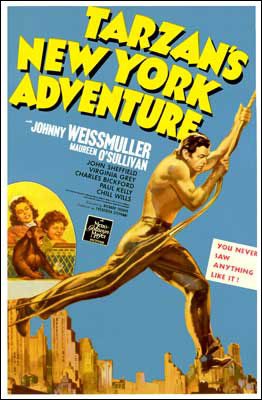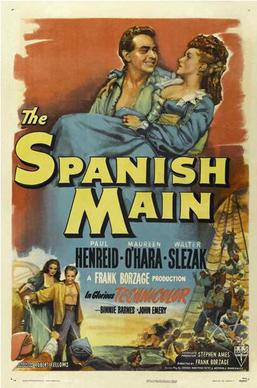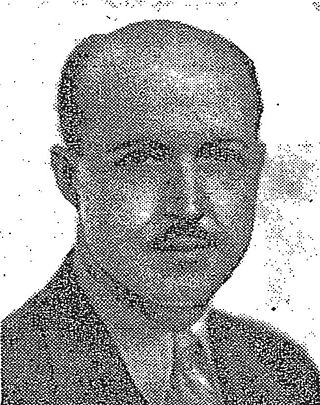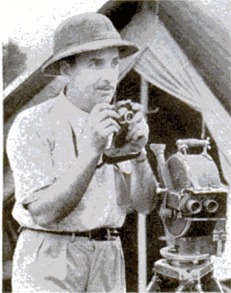The Van Beuren Corporation was a New York City-based animation studio that produced theatrical cartoons as well as live-action short-subjects from the 1920s to 1936.

Jungle Book is a 1942 independent Technicolor action-adventure film by the Korda brothers, loosely adapted from Rudyard Kipling's The Jungle Book (1894). The story centers on Mowgli, a feral young man who is kidnapped by villagers who are cruel to the jungle animals as they attempt to steal a dead king's cursed treasure. The film was directed by Zoltán Korda and produced by his brother Alexander, with the art direction by their younger brother Vincent. The screenplay was written by Laurence Stallings. The film stars Indian-born actor Sabu as Mowgli. Although the film is in the public domain, the master 35mm elements are with ITV Studios Global Entertainment. An official video release is currently available via The Criterion Collection.

Tarzan's New York Adventure is a 1942 American adventure film from Metro Goldwyn Mayer, produced by Frederick Stephani, directed by Richard Thorpe, that stars Johnny Weissmuller and Maureen O'Sullivan. This was the sixth and final film in MGM's Tarzan series and was the studio's last Tarzan feature until 1957's Tarzan and the Lost Safari. Although Tarzan's New York Adventure includes scenes set in New York, as well as the customary jungle sequences, it is yet another Tarzan production primarily shot on MGM's back lots.

The Spanish Main is a 1945 American adventure film starring Paul Henreid, Maureen O'Hara, Walter Slezak and Binnie Barnes, and directed by Frank Borzage. It was RKO's first all-Technicolor film since Becky Sharp ten years before.

Frank Howard Buck was an American hunter, animal collector, and author, as well as a film actor, director, and producer. Beginning in the 1910s he made many expeditions into Asia for the purpose of hunting and collecting exotic animals, bringing over 100,000 live specimens back to the United States and elsewhere for zoos and circuses and earning a reputation as an adventurer. He co-authored seven books chronicling or based on his expeditions, beginning with 1930's Bring 'Em Back Alive, which became a bestseller.

Jungle Menace (1937) is the first serial released by Columbia Pictures.

Harry L. Fraser was an American film director and screenplay writer.

Armand Georges Denis was a Belgian-born documentary filmmaker. After several decades of pioneering work in filming and presenting the ethnology and wildlife of remote parts of Africa and Asia, he became best known in Britain as the director and co-presenter of natural history programmes on television in the 1950s and 1960s, with his second wife Michaela.

Charlotte Virginia Henry was an American actress who is best remembered for her roles in Alice in Wonderland (1933) and Babes in Toyland (1934). She also starred in the Frank Buck serial Jungle Menace (1937).

Clyde Ernest Elliott was an American motion picture director, producer, and writer. He is best known for animal films, especially Frank Buck’s first movie, Bring 'Em Back Alive (1932).

Charles E. Ford was a newsreel and film producer and the director of Frank Buck's jungle movie Jacaré (1942).

James Melven Dannaldson starred in the Frank Buck film Jacaré.

All in a Lifetime by Frank Buck, with Ferrin Fraser, is Buck’s autobiography.

Bring ‘Em Back Alive is a 1930 book by Frank Buck. His first book, it was a best seller that catapulted him to world fame and was translated into many languages. Buck tells of his adventures capturing exotic animals.

Bring 'Em Back Alive is a 1932 American Pre-Code jungle adventure documentary filmed in Malaya starring Frank Buck. The film was promoted with an NBC radio series of the same title. The film's copyright was renewed in 1959, meaning it will enter the public domain in 2028.

Fang and Claw is a 1935 jungle adventure documentary starring Frank Buck. Buck continues his demonstration of the ingenious methods by which he traps wild birds, mammals and reptiles in Johore.

Wild Cargo was Frank Buck's second book, a bestseller. Buck, was born on March 17, 1884, in a wagon yard owned by his father at Gainesville, When he was five, his family moved to Dallas. After attending public schools in Dallas, Buck left home at the age of eighteen to take a job handling a trainload of cattle being sent to Chicago. In 1911, he made his first expedition to South America. He eventually also traveled to Malaya, India, Borneo, New Guinea, and Africa. From these and other expeditions, he brought back many exotic species that he sold to zoos and circuses, and he ultimately acquired the nickname "Bring 'Em Back Alive". Buck continued his tales of his adventures capturing exotic animals. Writing with Edward Anthony, Buck related many of his experiences working with and transporting jungle creatures.

Leroy Garfield Phelps was an American cinematographer who filmed Frank Buck’s second movie, Wild Cargo.

Harry E. Squire (1890-1977) was a cinematographer who filmed Frank Buck’s third movie, Fang and Claw, and later photographed This is Cinerama and other features in Cinerama.

Nicholas Cavaliere was a cinematographer who filmed Frank Buck’s films Bring 'Em Back Alive (1932), Wild Cargo (1934), and Fang and Claw (1935).




















